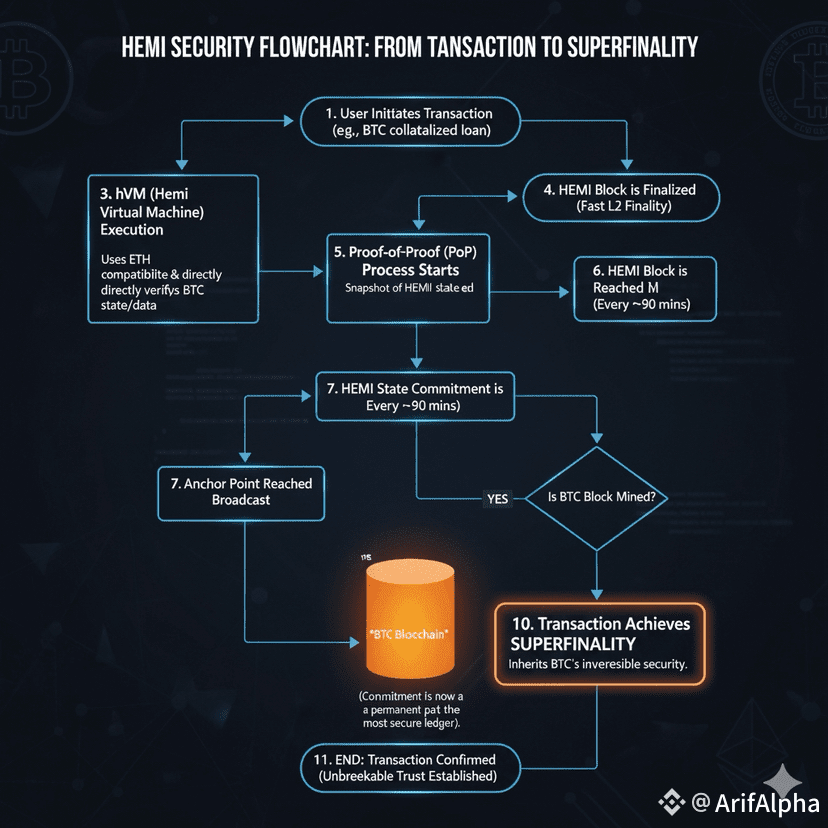The story of crypto has long been a tale of two giants existing in separate worlds: Bitcoin (BTC), the fortress of security and ultimate scarcity, and Ethereum (ETH), the boundless land of programmable finance. The industry's biggest challenge isn't just scaling; it’s building a bridge between these two that isn't a single point of failure. HEMI is not a bridge; it’s the fusion, creating a "Supernetwork" with a security framework engineered for an era of $100 billion-plus market cap assets.
This isn’t just marketing jargon. HEMI applies the core security mechanics of both BTC and ETH in a unique, layered defense system that’s setting a new benchmark for cross-chain trust.
The Fusion Architecture (The 'Better-Than-Bitcoin' Finality)
HEMI’s genuine innovation lies in its architecture, specifically two key components: Proof-of-Proof (PoP) consensus and the Hemi Virtual Machine (hVM).
1. The Bitcoin Anchor: Proof-of-Proof (PoP) —Superfinality
Bridge hacks have cost the crypto world billions. Traditional bridges rely on multisigs or external validators, creating a centralized risk. HEMI replaces this with PoP.
• How it Works: The HEMI Layer-2 chain doesn't just run parallel to Bitcoin; it anchors its entire state to it. Think of it like taking a cryptographically sealed snapshot of the entire HEMI chain every few hours and permanently embedding it into the most secure blockchain in existence.
• The Security Boost: This is called Superfinality. Once a transaction is "committed" via PoP onto the Bitcoin chain, it inherits the $100 billion-plus hash power and irreversible ledger of Bitcoin itself. Any attempt to reorganize or tamper with the HEMI chain would require a double-spend attack on Bitcoin—a near-impossible feat. This level of finality is essentially "better than Bitcoin" because it leverages BTC's security for faster settlement.
2. The Ethereum Engine: Hemi Virtual Machine (hVM) — Native Verification
The security advantage is paired with flexibility. HEMI is an EVM-compatible environment, but with a critical difference: the hVM embeds a full Bitcoin node inside the EVM.
• How it Works: This allows Ethereum-style smart contracts to directly query and interact with the native state of the Bitcoin blockchain (UTXOs, block headers, etc.) without relying on external oracles or wrapped tokens.
• The Security Boost: For the first time, an ETH-compatible DeFi protocol can verify, for instance, a BTC-collateralized loan natively using immutable Bitcoin data. This removes the "trust layer" entirely. If the Bitcoin-side data is verifiable on-chain, the ETH-side smart contract execution is automatically secure and trust-minimized.
HEMI Security Flowchart: From Transaction to Superfinality

Real-World Use Case and Deep-Dive Insight
HEMI’s security design solves a clear, persistent problem, opening up new, institutionally-ready DeFi applications.
Real-Life Scenario: The "Institutional" BTC Loan
Imagine a sophisticated DeFi protocol on HEMI, which wants to offer a major institution a large, decentralized loan collateralized by native BTC.
1. Old Way (High Risk): The institution would have to send its BTC to a third-party, potentially centralized bridge, receiving a wrapped token (like wBTC) in return. This wrapped token relies on the security of the custodian/bridge, which is prone to failure and regulatory risk.
2. HEMI Way (Trust-Minimized): The institution deposits native BTC into a specific HEMI Tunnel contract. The hVM, which has native visibility into the Bitcoin chain, verifies the BTC deposit state. An ETH-compatible smart contract on HEMI then issues the loan based on this direct, cryptographically-proven collateral. The security is inherited directly from the original BTC network via PoP anchoring, and the execution is proven by ETH's smart contract engine. No single bridge entity is custodizing the assets or the state; the security is distributed and verifiable across both foundational chains.
• Deep-Dive Data Point: Recent on-chain data shows HEMI's Total Value Locked (TVL) exceeded $1.2 Billion shortly after its mainnet launch, with over 2,600 BTC and 3,200 ETH settled on the chain. This rapid inflow of real assets underscores market confidence in its unique, dual-layer security model against a backdrop of ongoing bridge exploits in the wider market.
Tapping into the L2 and Interoperability Trend
The market is currently obsessing over L2 scaling and secure cross-chain interoperability. HEMI’s launch is timely because it addresses the core weakness of most L2 solutions: the security of their state transitions.
HEMI doesn't just connect two chains; it leverages the intrinsic value of both: BTC's trust and ETH's utility. It moves beyond the idea of an L2 being just a "rollup" for one chain, pioneering the concept of a "secured-by-two-chains" modular execution environment. This is exactly where the sophisticated conversation around multi-chain strategy is headed.
The ability for developers to use familiar ETH tooling to build DApps that can directly access and rely on BTC data significantly lowers the barrier for BTC to become a truly liquid and programmable asset class. This is not just a technological step forward; it’s a necessary market evolution.
The Final Takeaway
The future of decentralized finance demands security without compromise and interoperability without fragility. HEMI’s innovative application of BTC's Proof-of-Work immutability via PoP and ETH's robust smart contract execution via hVM provides an answer that is both unique and deeply professional. It shifts the narrative from battling chains to bolstering a shared security layer.
Question to Spark Conversation: As more Layer-2 solutions look to inherit Bitcoin’s security, do you believe the BTC network's primary role is evolving from just a "Store of Value" to a foundational "Global Security and Settlement Layer" for the entire crypto ecosystem?